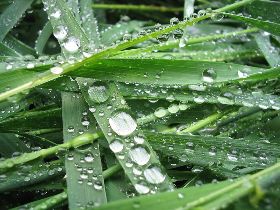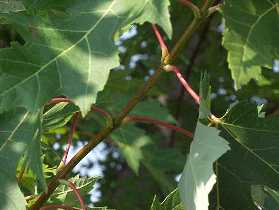Food is Comfort
 Nutrients are brought into the plant by the
roots and the
leaves. Photosynthesis in the leaves allows for energy to be
converted from solar energy to usable energy in the form of
sugars. While water, which holds nutrients, is taken up by the
root hairs; this helps with energy as well. Accumulated
energy is stored in the form of starch.
Nutrients are brought into the plant by the
roots and the
leaves. Photosynthesis in the leaves allows for energy to be
converted from solar energy to usable energy in the form of
sugars. While water, which holds nutrients, is taken up by the
root hairs; this helps with energy as well. Accumulated
energy is stored in the form of starch.
To transport sugar and water from one end of the tree to the
other, specific transport tissue is used. These tissues are
called xylem and phloem. Xylem
tissue is used
for the transport of water; most commonly this is up the plant.
Phloem tissue is used to move sugars, and this occurrence is
usually down the plant.
 The xylem is found on the inside of the vascular cambium. Xylem
works very similar to a straw. As water is evaporated from the
leaves (transportation), negative pressure is created. Because
water travels from positive to negative pressure, water is
pulled from the roots through the xylem up to the leaves. It is
also assisted by adhesion, cohesion and tension.
The xylem is found on the inside of the vascular cambium. Xylem
works very similar to a straw. As water is evaporated from the
leaves (transportation), negative pressure is created. Because
water travels from positive to negative pressure, water is
pulled from the roots through the xylem up to the leaves. It is
also assisted by adhesion, cohesion and tension.
Phloem tissue is a combination of sieve-tube elements and
companion cells found outside of the vascular cambium. The
transport of sugars that occurs in these cells are caused by
pressure, causing the sugars to travel from the source to the sinks. Sugar is most often accumulated in the leaves, called the
source, and then are actively transported into the phloem. This causes a
high concentration of sugar compared to water in the phloem
tissues resulting in water diffusion from the xylem. The
pressure created by all the sugars and water in the phloem tissue
forces sugars to spread both up and down to the sinks. Sinks are
areas of the plant that are actively growing or other areas in
need of sugars.
sinks. Sugar is most often accumulated in the leaves, called the
source, and then are actively transported into the phloem. This causes a
high concentration of sugar compared to water in the phloem
tissues resulting in water diffusion from the xylem. The
pressure created by all the sugars and water in the phloem tissue
forces sugars to spread both up and down to the sinks. Sinks are
areas of the plant that are actively growing or other areas in
need of sugars.
Between these two tissues all water and food can be distributed
to all the cells of Acer saccharinum.
Continue on and learn how Acer saccharinum has
adapted to become such a prominent
species.